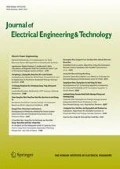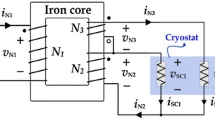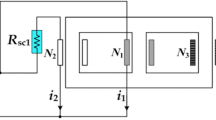Abstract
In this paper, a transformer type superconducting fault current limiter (SFCL) with two isolated secondary windings was fabricated to increase the current limiting capacity. As the magnetization current increased due to the large transient fault current immediately after the fault, the magnetization force variation, the operating range of the flux linkage, and the voltage region variation were compared at fault angles of 0° and 90°, respectively. The short-circuit test analyzed the current limiting operation, power consumption, and energy consumption characteristics according to the fault angle immediately after the fault occurrence. The results showed that the fault angle of 0° could limit the fault current much more than the fault angle of 90°. In addition, it was confirmed that the magnetization force variation, the operating range of the flux linkage, and the voltage induced in the primary winding were all much larger at the fault angle of 0° than at the fault angle of 90°.









Similar content being viewed by others
References
Noe M, Steurer M (2007) High-temperature superconductor fault current limiters: Concepts, applications, and development status. Supercond Sci Technol 20(3):R15–R29
Barzegar-Bafrooei M, Foroud A, Ashkezari J, Niasati M (2019) On the advance of SFCL: a comprehensive review. IET Gener Transm Distrib 13(17):3745–3759
Wheeler K, Elsamahy M, Faried S (2017) Use of superconducting fault current limiters for mitigation of distributed generation influences in radial distribution network fuse-recloser protection systems. IET Gener Transm Distrib 11(7):1605–1612
Neumueller HW et al (2009) Development of resistive fault current limiters based on YBCO coated conductors. IEEE Trans Appl Supercond 19(3):1950–1955
Xin Y et al (2009) Manufacturing and test of a 35 kV/90 MVA saturated iron-core type superconductive fault current limiter for live-grid operation. IEEE Trans Appl Supercond 19(3):1934–1937
Hekmati (2015) Multi-objective design of tunable shield-type superconducting fault current limiter. IEEE Trans Appl Supercond 25(5):5602908
Salim KM, Hoshino T, Kawasaki A, Muta I, Nakamura T (2003) Waveform analysis of the bridge type SFCL during load changing and fault time. IEEE Trans Appl Supercond 13(2):1992–1995
Ko SC, Han TH, Lim SH (2020) Magnetizing characteristics of bridge type superconducting fault current limiter (SFCL) with simultaneous quench using flux-coupling. Energies 13(7):1760
Hyun OB, Sim J, Kim HR, Park KB, Yim SW, Oh IS (2009) Reliability enhancement of the fast switch in a hybrid superconducting fault current limiter by using power electronic switches. IEEE Trans Appl Supercond 19(3):1843–1846
Lee GH et al (2009) Hybrid superconducting fault current limiter of the first half cycle non-limiting type. IEEE Trans Appl Supercond 19(3):1888–1891
Choi HS, Lim SH (2007) Operating performance of the flux-lock and the transformer type superconducting fault current limiter using the YBCO thin films. IEEE Trans Appl Supercond 17(2):1823–1826
Lim SH, Moon JF, Kim JC (2009) Improvement on current limiting characteristics of a flux-lock type SFCL using E-I core. IEEE Trans Appl Supercond 19(3):1904–1907
Ren L et al (2010) Techno-economic evaluation of a novel flux-coupling type superconducting fault current limiter. IEEE Trans Appl Supercond 20(3):1242–1245
Yan S et al (2018) Electromagnetic design and performance analysis of a flux-coupling-type SFCL. IEEE Trans Appl Supercond 28(3):5600305
Lee BW, Park KB, Sim J (2018) Design and experiments of novel hybrid type superconducting fault current limiters. IEEE Trans Appl Supercond 18(2):624–627
Ko SC, Han TH, Lim SH (2014) Analysis on current limiting characteristics according to the influence of the magnetic flux for SFCL with two magnetic paths. J Elect Eng Technol 9(6):1909–1913
Lim SH, Kim YP, Ko SC (2016) Effect of peak current limiting in series-connection SFCL with two magnetically coupled circuits using E-I core. IEEE Trans Appl Supercond 26(3):5600404
Yu B, Han TH, Lim SH, Kim YP, Ko SC (2018) Comparison of dual peak current limiting operation for a series-connected SFCL using two iron cores. IEEE Trans Appl Supercond 28(4):5600704
Han TH, Ko SC, Lim SH (2018) Fault current limiting characteristics of transformer-type superconducting fault current limiter due to winding direction of additional circuit. IEEE Trans Appl Supercond 28(3):5601906
Han TH, Ko SC, Lim SH (2018) Peak current limiting characteristics of transformer type superconducting fault current limiters with two non-isolated secondary windings. IEEE Trans Appl Supercond 28(4):5603205
Ko SC, Lim SH (2016) Analysis on magnetizing characteristics due to peak fault current limiting operation of a modified flux-lock-type SFCL with two magnetic paths. IEEE Trans Appl Supercond 26(4):5601605
Acknowledgements
This research was supported by Basic Science Research Program through the National Research Foundation of Korea (NRF) funded by the Ministry of education (2018R1D1A1B07040471) and funded by the Ministry of education (2018R1D1A1B09083558).
Author information
Authors and Affiliations
Corresponding author
Additional information
Publisher's Note
Springer Nature remains neutral with regard to jurisdictional claims in published maps and institutional affiliations.
Rights and permissions
About this article
Cite this article
Han, TH., Lim, SH. & Ko, SC. Magnetization Characteristics Due to Fault Angle of Transformer Type SFCL with Two Isolated Secondary Windings. J. Electr. Eng. Technol. 15, 2501–2508 (2020). https://doi.org/10.1007/s42835-020-00534-2
Received:
Revised:
Accepted:
Published:
Issue Date:
DOI: https://doi.org/10.1007/s42835-020-00534-2




